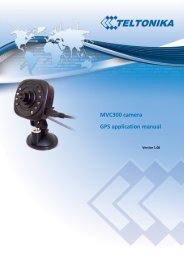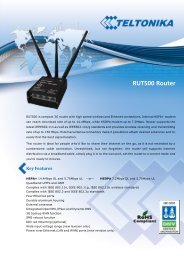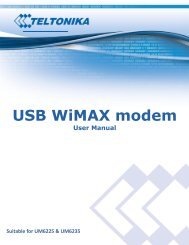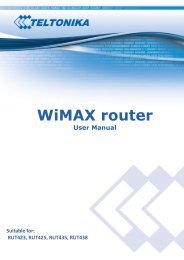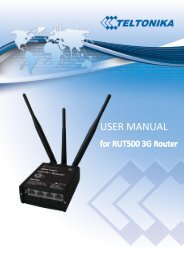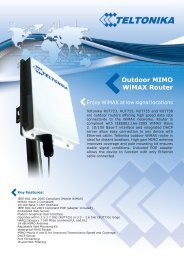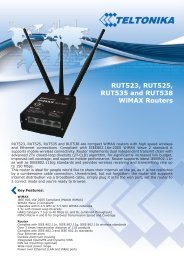TELTONIKA Find the available serial ports Since Linux only support ...
TELTONIKA Find the available serial ports Since Linux only support ...
TELTONIKA Find the available serial ports Since Linux only support ...
You also want an ePaper? Increase the reach of your titles
YUMPU automatically turns print PDFs into web optimized ePapers that Google loves.
<strong>TELTONIKA</strong><br />
<strong>Linux</strong> PCI manual<br />
<strong>Find</strong> <strong>the</strong> <strong>available</strong> <strong>serial</strong> <strong>ports</strong><br />
<strong>Since</strong> <strong>Linux</strong> <strong>only</strong> <strong>support</strong> 4 <strong>serial</strong> <strong>ports</strong> (ttyS0, ttyS1, ttyS2, ttyS3) under <strong>the</strong> default condition. Most<br />
likely, ttyS0 & ttyS1 are <strong>support</strong>ed by mo<strong>the</strong>r board's built-in <strong>serial</strong> controllers and ttyS2 & ttyS3 are free<br />
for additional I/O card.<br />
Serial <strong>ports</strong> could be checked by <strong>the</strong> following commands.<br />
set<strong>serial</strong> /dev/ttyS0 -a<br />
(COM-1)<br />
set<strong>serial</strong> /dev/ttyS1 -a<br />
(COM-2)<br />
set<strong>serial</strong> /dev/ttyS2 -a<br />
(COM-3)<br />
set<strong>serial</strong> /dev/ttyS3 -a<br />
(COM-4)<br />
If COM-1 is used by mouse, <strong>the</strong> response is similar to<br />
/dev/ttyS0 : Device or resource busy<br />
If <strong>the</strong> COM-1 does not attach any device, <strong>the</strong> response is similar to<br />
/dev/ttyS0, Line 0, UART: 16550A, Port: 0x3f8, irq: 4<br />
Baud_base: 115200, clos_delay: 50, divisor: 0<br />
closing_wait: 3000, closing_wait2: infinite<br />
Flags: spd_normal skip_test<br />
In case ttyS2 (COM-3) is free, <strong>the</strong> response for command set<strong>serial</strong> /dev/ttyS2 -a is shown below.<br />
/dev/ttyS2, Line 2, UART: unknown, Port: 0x3e8, irq: 4<br />
Baud_base: 115200, clos_delay: 50, divisor: 0<br />
closing_wait: 3000, closing_wait2: infinite<br />
Flags: spd_normal skip_test<br />
<strong>Find</strong> <strong>the</strong> PCI card resource ( I/O port address & IRQ) for <strong>the</strong> <strong>serial</strong> <strong>ports</strong><br />
Enter <strong>the</strong> command<br />
more /proc/pci<br />
The response is similar to <strong>the</strong> following<br />
Bus 0, Device 11, function 0:<br />
Serial controller : Unknown vendor Unknown device (rev 01).<br />
Vendor id=9710, Device id=9820<br />
Medium devsel. Fast back-to-back capable. IRQ 11 (IRQ depends on PCI)<br />
Board with Nm9835CV part<br />
I/O at 0xc000 [0xc001] <strong>serial</strong> port 1<br />
I/O at 0xc400 [0xc401] not used<br />
I/O at 0xc800 [0xc801] not used<br />
I/O at 0xd000 [0xd001] not used<br />
I/O at 0xd400 [0xd401] not used<br />
Address: Žirmūnų g. 27, Vilnius LT-09105,<br />
Tel.: +370 5 2127472,<br />
Fax: +3705 276 1380, E-mail: info@teltonika.lt
<strong>TELTONIKA</strong><br />
<strong>Linux</strong> PCI manual<br />
I/O at 0xd800 [0xd801]<br />
not used<br />
From <strong>the</strong> /proc/pci file, it is possible to find <strong>the</strong> PCI card's I/O port address and IRQ. Especially, <strong>the</strong><br />
NetMos parts always shows:<br />
Vendor id=9710, Device id=9820<br />
Configure <strong>the</strong> parameters for ttyS2 or ttyS3<br />
Enter (if ttyS2 or ttyS3 are free):<br />
set<strong>serial</strong> /dev/ttyS2 port 0xc000 UART 16550A<br />
irq 11 Baud_base 115200<br />
set<strong>serial</strong> /dev/ttyS3 port 0xc008 UART 16550A<br />
irq 11 Baud_base 115200<br />
Check <strong>the</strong> setting for ttyS2 or ttyS3<br />
Type set<strong>serial</strong> /dev/ttyS2 –a :<br />
/dev/ttyS2, Line 2, UART: 16550A, Port: 0xc000, irq: 11<br />
Baud_base: 115200, clos_delay: 50, divisor: 0<br />
closing_wait: 3000, closing_wait2: infinite<br />
Flags: spd_normal skip_test<br />
The ttyS2 or ttyS3 are ready for application<br />
GPRS settings<br />
To be able to use GPRS, you should configure your dialer to initialize <strong>the</strong> modem with following init<br />
strings (replace 'your.apn.here' with appropriate APN):<br />
ATZ<br />
AT&FV1&D2&S0&C1S0=0<br />
AT+CGDCONT=1,"IP","your.apn.here"<br />
PPP Internet connection can be established by dialing to <strong>the</strong> phone number '*99#'.<br />
Address: Žirmūnų g. 27, Vilnius LT-09105,<br />
Tel.: +370 5 2127472,<br />
Fax: +3705 276 1380, E-mail: info@teltonika.lt
<strong>TELTONIKA</strong><br />
<strong>Linux</strong> PCI manual<br />
Example<br />
To connect to <strong>the</strong> internet over GPRS using wvdial dialer you can use <strong>the</strong> following configuration file<br />
(/etc/wvdial.conf):<br />
Launch terminal in <strong>Linux</strong>, you must enter as root <strong>the</strong>n launch:<br />
wvdialconf /etc/wvdial.conf<br />
It will create wvdial.conf file in /etc/ folder, when edit this file and enter such parameters<br />
[Dialer Defaults]<br />
Modem = /dev/ttyS2<br />
;(Modem= /dev/ttyS2 )<br />
;(Modem= /dev/ttyS3)<br />
Baud = 115200<br />
Init1 = ATZ<br />
Init2 = AT&FV1&D2&S0&C1S0=0<br />
Username= your login<br />
Password= your password<br />
[Dialer gprs]<br />
Phone = *99#<br />
Init3= AT+CGDCONT=1,"IP","your.apn.here"<br />
Note: You need to replace ‘your login', 'your password' and 'your.apn.here'<br />
with values appropriate for your GSM operator.<br />
After that, enter in terminal such command:<br />
wvdial --config /etc/wvdial.conf gprs<br />
Modem will connect to <strong>the</strong> internet, to stop connection press in <strong>the</strong> terminal CTRL+C.<br />
Address: Žirmūnų g. 27, Vilnius LT-09105,<br />
Tel.: +370 5 2127472,<br />
Fax: +3705 276 1380, E-mail: info@teltonika.lt



